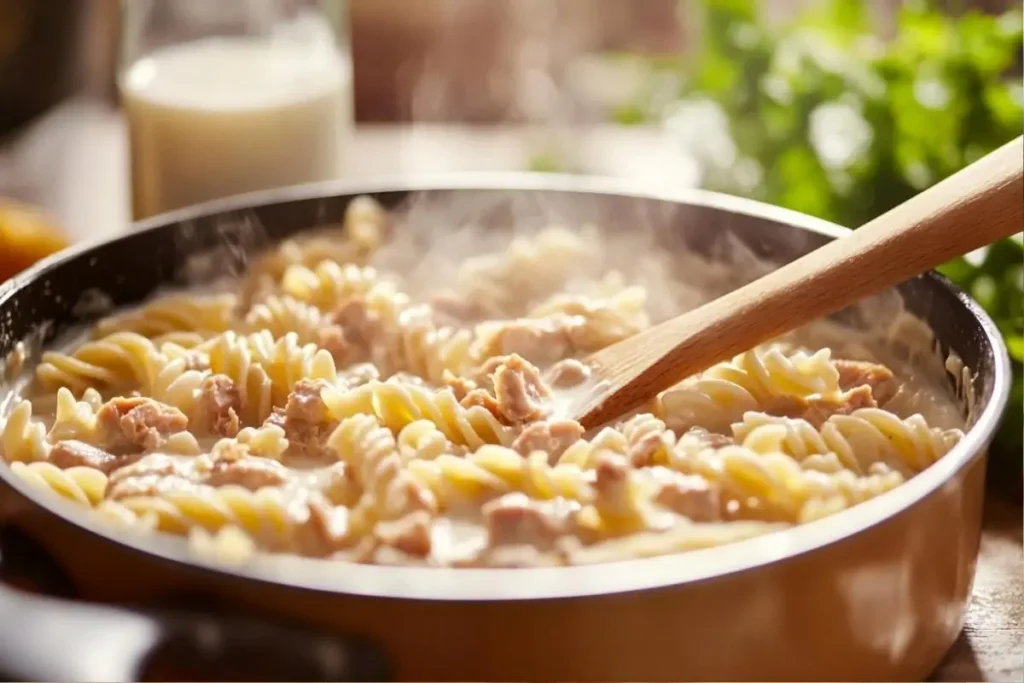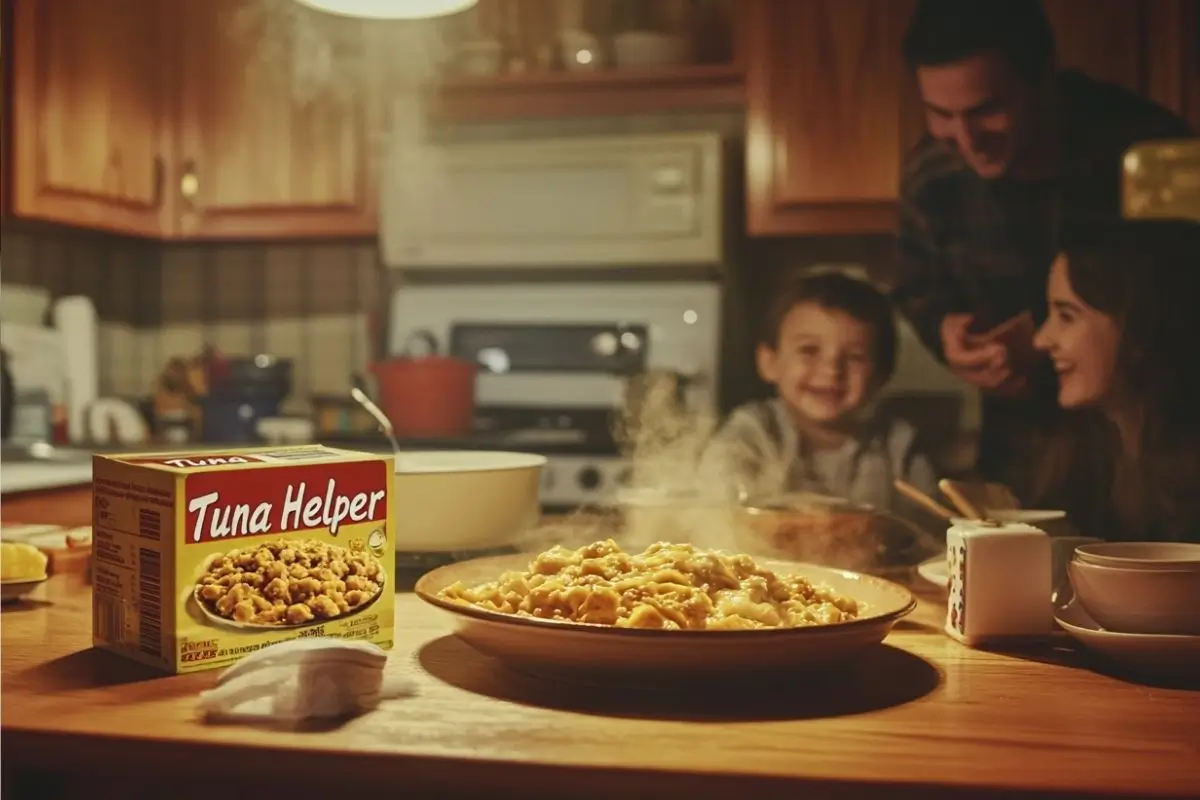Tuna Helper—heard of it? If you grew up in the U.S., chances are you’ve seen this boxed meal kit in grocery stores. But is Tuna Helper a thing people still eat today? Or has it faded into food history, replaced by healthier homemade Tuna Helper alternatives?
In this article, we’ll take a deep dive into Tuna Helper—where it came from, why it was so popular, and whether people still use it today. We’ll also explore healthier homemade alternatives, discuss ingredient swaps, and answer common questions like how many cans of tuna does it take? or how long does it take to cook?
Let’s dive in!
Is Tuna Helper a Thing? Understanding the Classic Boxed Meal
The Origin of Tuna Helper
Tuna Helper is a boxed tuna pasta meal designed to turn a simple can of tuna into a complete, creamy dish. Manufactured by Betty Crocker, this quick dinner solution includes pasta, seasonings, and a sauce mix, making it a convenient meal for busy families.
Tuna Helper was introduced in the late 1970s as an expansion of the Hamburger Helper line. At the time, boxed meal kits were gaining popularity due to their affordability and ease of preparation. Betty Crocker capitalized on this trend by creating a version tailored for canned tuna, a staple in many households.
How It Became a Pantry Staple
The idea behind Tuna Helper was simple:
- Convenience – With just a few pantry staples (like milk and butter), anyone could prepare a hearty meal in under 30 minutes.
- Affordability – Since canned tuna was cheaper than fresh meat, it made for a budget-friendly dinner option.
- Variety – Over time, different flavors like Cheesy Pasta, Creamy Broccoli, and Tetrazzini were introduced to cater to different tastes.
The Role of Boxed Meal Kits in American Kitchens
During the late 20th century, boxed meal kits like Tuna Helper became household essentials. These pre-packaged solutions helped working parents put dinner on the table quickly and affordably. Today, while fewer people rely on boxed meal kits, many still have fond memories of these classic comfort foods.
But is Tuna Helper a thing that still holds a place in today’s kitchens, or has it been replaced by homemade alternatives? Keep reading to find out!
The History of Tuna Helper – Is Tuna Helper a Thing That Still Exists?
When Did Tuna Helper Come Out?
Tuna Helper was introduced in 1979 as an extension of the Hamburger Helper line, which had already gained immense popularity in the 1970s. With American families looking for quick, budget-friendly meals, Betty Crocker saw an opportunity to expand its boxed dinner lineup beyond just beef-based options.
By the late 20th century, convenience foods were in high demand, and Tuna Helper provided a simple solution: just add canned tuna, milk, and butter, and dinner was ready in under 30 minutes.
The Evolution of Tuna Helper Flavors
Over the years, Tuna Helper expanded its lineup with multiple flavors to suit different tastes, including:
- Tuna Cheesy Pasta – A creamy, cheesy pasta-based option.
- Tuna Creamy Broccoli – A mix of broccoli flavors with a rich sauce.
- Tuna Tetrazzini – A spin on the classic Italian dish.
However, despite its initial popularity, several flavors were discontinued due to changing consumer preferences and the rise of homemade alternatives.
How Hamburger Helper Inspired Tuna Helper
Tuna Helper wouldn’t exist without the success of Hamburger Helper, which was introduced in 1971 to help families stretch their ground beef supply. Seeing its success, Betty Crocker applied the same concept to canned tuna—a cheaper, more shelf-stable protein.
Over time, Tuna Helper became a staple in many homes, particularly in the 1980s and 1990s, when boxed meal kits were at their peak. But is Tuna Helper a thing people still rely on, or has the rise of homemade Tuna Helper alternatives made the boxed version obsolete?
👉 Want a better-tasting, homemade version of Tuna Helper? Check out this creamy, easy homemade Tuna Helper recipe for a healthier, tastier meal!
Why Do People Look for Homemade Alternatives?
Although Tuna Helper remains on store shelves, many people are searching for a Tuna Helper alternative that’s healthier and homemade. But is Tuna Helper a thing that still fits modern eating habits?

The Downside of Store-Bought Tuna Helper
While Tuna Helper is quick and easy, it has some drawbacks, including:
- High Sodium Content – Many boxed meal kits are loaded with salt and preservatives.
- Artificial Ingredients – The boxed version contains additives and artificial flavors that some prefer to avoid.
- Limited Customization – You can’t adjust the seasoning, cheese, or type of pasta as easily as you can with a homemade Tuna Helper recipe.
Healthier and More Customizable Options
Making a homemade Tuna Helper allows for:
- Fresh Ingredients – Using real cheese, whole-wheat pasta, and fresh herbs improves both taste and nutrition.
- Customizable Flavors – Adjust creaminess, seasoning, and pasta type to fit your preferences.
- Lower Sodium & Preservatives – Control the salt and additives in your dish.
How Homemade Tuna Helper Compares in Taste and Nutrition
A homemade Tuna Helper alternative can be:
✅ More flavorful – No artificial aftertaste, just pure creamy goodness.
✅ More nutritious – Fresh ingredients mean fewer preservatives.
✅ More cost-effective – If you have pasta, cheese, and milk, you can make it cheaper than the boxed version.
With modern families opting for healthier home-cooked meals, it’s no surprise that is Tuna Helper a thing many still buy? Or are they moving toward homemade Tuna Helper recipes instead?
👉 Try this Papas Locas Loaded Flavor Recipe – A cheesy, hearty comfort food recipe relevant to those looking for alternative quick meals.
Tuna Helper is traditionally made with canned tuna, but what if you don’t have any? Is Tuna Helper a thing that can be made with other proteins or vegetarian alternatives? Absolutely!
Is Tuna Helper a Thing You Can Make Without Tuna? Alternative Proteins & Substitutes
Substitutes for Tuna in Tuna Helper
If you’re out of canned tuna or want a Tuna Helper substitute, here are some great alternatives:
- Canned Chicken – A milder protein that pairs well with cheesy, creamy sauces.
- Salmon – A richer, slightly oilier fish that works great in Tuna Helper alternatives.
- Shrimp – Adds a seafood twist to creamy pasta meals.
Vegetarian and Vegan Adaptations
For a meat-free version, try:
- Mushrooms – A savory, umami-rich alternative to tuna in creamy pasta dishes.
- Chickpeas – A protein-packed, hearty replacement for canned tuna.
- Vegan Cheese & Plant-Based Milk – Make it 100% dairy-free while keeping the creamy texture.
The flexibility of Tuna Helper alternatives makes it easy to customize for any diet. But is Tuna Helper a thing that people are still using as a meal base, or are they moving toward fully homemade versions?
👉 Check out this Salmon Crudo Recipe – Ideal for readers considering seafood alternatives.
How Many Cans of Tuna Does Tuna Helper Take?
One of the most common questions about Tuna Helper is: How much tuna should you use? If you’re using a boxed Tuna Helper meal kit, the instructions usually recommend:
- One standard 5 oz can of tuna (drained) per box.
Serving Sizes and Tuna Helper Box Instructions
The amount of canned tuna per serving depends on your preference. Some people double up on tuna, while others prefer a milder flavor.
- 1 can (5 oz) – Balanced flavor and texture (recommended).
- 2 cans (10 oz) – Extra protein for seafood lovers.
- ½ can (2.5 oz) – A lighter taste, great for kids or picky eaters.
Adjusting the Recipe for More or Less Tuna
If you’re making a homemade Tuna Helper recipe, you have total control over the amount of tuna! Want it richer? Add more! Prefer just a hint of seafood? Use less tuna and more sauce.
So, is Tuna Helper a thing that still follows the old-school 1-can rule, or are people making customized, homemade versions instead?
While Tuna Helper provides a quick and easy meal, many consumers are shifting away from processed foods due to concerns over added preservatives and artificial ingredients. According to Healthline, reducing processed food intake can lead to better digestion, lower inflammation, and improved overall health. This shift has led many to explore homemade alternatives that offer more natural ingredients and customizable flavors.
👉 Make a Perfect Philly Cheesesteak Tortellini – A different pasta-based dish for those interested in creamy, cheesy comfort meals.
How Long Does Tuna Helper Take to Cook?

One of the main reasons people choose Tuna Helper is its quick and easy preparation. But how long does it actually take to cook?
Average Cooking Time for Boxed Tuna Helper
A standard Tuna Helper meal takes about 20-30 minutes to prepare, depending on the flavor and method used. The steps typically include:
- Boiling the pasta – Takes about 10 minutes.
- Mixing the sauce and seasonings – Takes about 5 minutes.
- Adding tuna and finishing touches – Another 5-10 minutes to blend flavors.
While this is relatively quick, some people find the boxed version lacking in taste or too processed. That’s why many opt for homemade alternatives.
Quick Hacks to Speed Up or Improve the Recipe
If you’re in a hurry, here are some tips to cut down cooking time while making it tastier:
- Use pre-cooked pasta – Saves about 5-7 minutes.
- Swap fresh ingredients for pre-prepped options – Pre-chopped onions, garlic, and pre-shredded cheese speed things up.
- Simmer the sauce while the pasta cooks – This allows flavors to develop simultaneously.
The Future of Tuna Helper
Over the decades, Tuna Helper has seen its rise and fall in popularity. But is Tuna Helper a thing that will stick around in the future, or will it become obsolete?
Is Tuna Helper Still Popular Today?
While Tuna Helper was a staple in the ’80s and ’90s, today’s consumers are shifting toward homemade Tuna Helper alternatives and healthier boxed dinner options. But why do people still eat Tuna Helper? Convenience and nostalgia play a role. With people avoiding processed foods and leaning into from-scratch cooking, many are looking for homemade versions of their favorite comfort foods.
That said, boxed meal kits still hold nostalgic value, and some busy households continue to rely on them for quick meals. Tuna Helper remains on store shelves, but its demand has significantly declined over the years.
New Trends in Convenient Meal Solutions
As more people focus on healthy eating, brands are adapting. New meal kits and boxed dinners now emphasize:
- Organic ingredients
- Low-sodium options
- Gluten-free and plant-based choices
With these trends, it’s possible that Tuna Helper could make a comeback—but in a healthier, modernized form. Until then, many home cooks continue to create DIY versions that offer better taste, nutrition, and flexibility.
Looking for more easy homemade meal ideas? Explore this collection of delicious recipes for inspiration!
Final Thoughts – Is Tuna Helper Still Relevant?
So, is Tuna Helper a thing people still eat today? The answer is yes and no. While boxed meal kits like Tuna Helper were once a kitchen staple, today’s health-conscious consumers are leaning toward homemade versions.
However, Tuna Helper alternatives still have a place, especially for those who:
✅ Need a quick and easy dinner solution.
✅ Prefer budget-friendly meals.
✅ Enjoy the nostalgia of classic comfort foods.
That said, homemade Tuna Helper recipes are often healthier, fresher, and more customizable.
👉 Need more inspiration? Explore this collection of delicious recipes – A general call-to-action leading to all your recipes.
FAQ
1. When Did Tuna Helper Come Out?
Tuna Helper was introduced in 1979 as an extension of the Hamburger Helper line. At the time, boxed meal kits were growing in popularity due to their affordability and convenience. It quickly became a favorite among families looking for easy-to-make dinners.
2. Can You Make Tuna Helper Without Tuna?
Absolutely! While canned tuna is the traditional protein, you can swap it out with:
- Canned chicken for a similar texture.
- Salmon for a richer, more flavorful dish.
- Mushrooms or chickpeas for a vegetarian-friendly alternative.
3. How Many Cans of Tuna Does Tuna Helper Take?
Most Tuna Helper recipes call for one 5-ounce can of tuna. However, if you prefer a heartier meal, you can add two cans or mix in extra vegetables like peas or mushrooms.
4. How Long Does Tuna Helper Take to Cook?
Tuna Helper is designed to be a quick meal, usually taking 25-30 minutes from start to finish. If you’re making a homemade version, it may take slightly longer, but the flavor and freshness make it worth the extra time!

